
| Home | Syllabus | Schedule | Lecture Notes | Extras | Glossary |

| Home | Syllabus | Schedule | Lecture Notes | Extras | Glossary |
We began with an announcement that the Office of Accessibility Resource Center is looking for a note taker for this course. This is a paid position. Interested students should visit 2021 Mesa Vista Hall to complete the hiring paperwork.
We reviewed the concept of quantitative traits from last time to illustrate that they are far more important in agricultural genetics and biomedical genetics than the relatively rare "Mendelian" traits that produce strong effects not influenced by other genes or by the environment.
Quantitative traits exhibit a continuous range of variation (height, weight, blood pressure, etc.), result from an interaction of genes and the environment, and are typically influenced by a large number of additive factors. I once again showed a slide of my risk factors for coronary heart disease to illustrate this point (I am at about average risk); the fifteen factors that I showed make up most of the approximately half of my risk that is contributed by genetics.
We reviewed that Mendel's key insight was to restrict his experiments to the study of how genes were transmitted, not on how they influenced traits. To achieve this, he picked traits for which hybrids between two true-breeding lines showed the phenotypic characteristics of a single parent, rather than being in between the parental lines. He was also very careful to quantify his results and understood the mathematics of his day, including probability.
We reviewed the discovery of chromosomes by Flemming, the cytology of meiosis as described by Boveri and Sutton, and the concept that disorders of metabolism could be inherited as described by Garrod. This puts us in the position of a scientist around 1908, except of course that we happen to also know that genes are made of DNA and generally encode proteins, which will help us to understand Mendel's results more easily than did his contemporaries.
Our concept maps now show that we understand that genes are units of heredity, operating as hereditary particles that are not influenced by their passage through hybrids. We know that chromosomes are very carefully divided during cell division, whether that is mitosis, which makes identical cells during growth, or meiosis, the special divisions that make haploid gametes. We suspect that genes are on chromosomes due to the effects of numerical aberrations like trisomy 21 (Down Syndrome), Turner Syndrome (45,X), and Kleinfelter Syndrome (47,XXY).
We briefly reviewed probability as discussed in the last lecture. The probability of an event is the likelihood of that event expressed as a frequency, a number bewteen zero and one. For the simple case of a coin toss, the likelihood of heads is 1/2 (or 0.5 or 50%).
The solution to the problem of what happens when we toss two coins is show visually below.
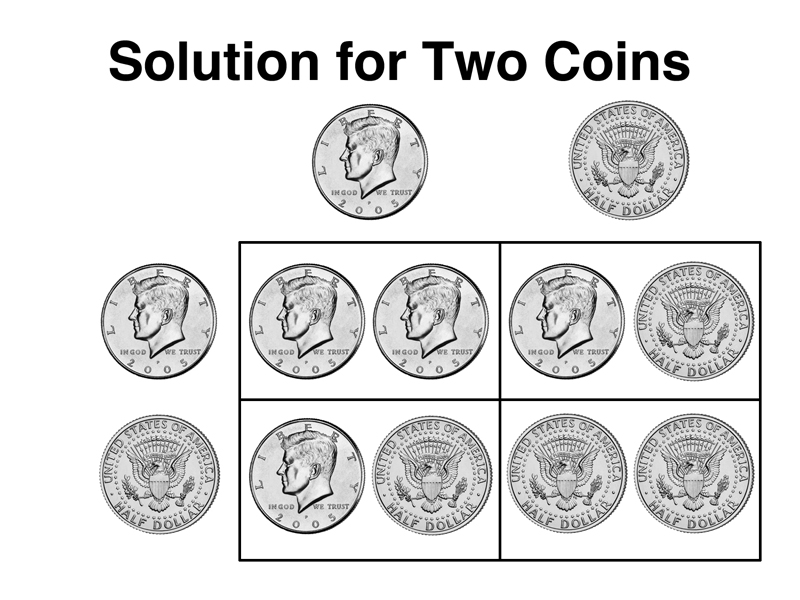
If both coins are fair, the probability of heads for each is 50%, likewise for tails. The four possible results in the sample space translate into three outcomes: two heads (p = 1/4), a head and a tail (p = 1/2), or two tails (p = 1/4). The figure also illustrates the Product Rule and the Sum Rule.
The Product Rule states that the probability of two independent events occurring together is the product of their individual probabilities. This is easily understood for coin tosses, which are independent. The probability of getting two heads on a toss of two coins is 1/2 x 1/2 = 1/4.
The Sum Rule states that the probability of either of two mutually exclusive events is the sum of their individual probabilities. In a trivial case, the probability of getting a head or a tail on the toss of a coin is 1/2 + 1/2 = 1. It's certain. There is nothing else that can happen. The probability of getting at least one head on the toss of two coins is 1/4 (the probability of getting two heads) + 1/2 (the probability of getting a head and a tail, with two ways to do this) = 3/4. The ratio of tosses that gives at least one head to those that give no heads is 3:1.
We also reviewed the results of monhybrid crosses of true-breeding black to true-breeding albino mice. Using the simple nomenclature of last time, we call the true-breeding black AA and the true-breeding albino aa, as shown in the cross below.
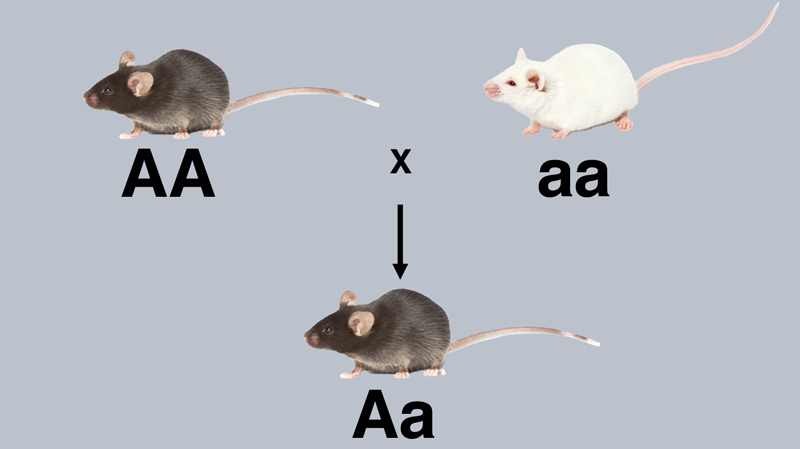
We can view this cross as the cross of a true-breeding black (AA) to a true-breeding albino (aa) to generate an F1 hybrid (Aa). We can also consider it to be an illustration of the only kinds of mice that there are in a monohybrid cross, the homozygous recessive (aa), and two kinds of black mice, one that yields only black hybrids in a testcross to aa, as in this case, and another that yields both black and albino in a testcross, as shown below.
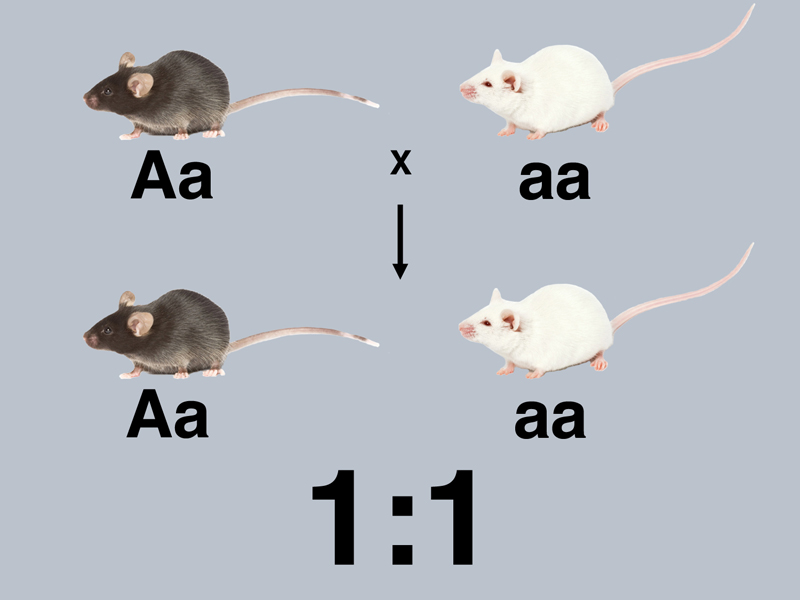
The black hybrids (Aa) produce a 1:1 ratio of black to albino in a testcross.
The F1 intercross (Aa x Aa) produces a 3:1 ratio of black (A-) to albino (aa), as shown below.
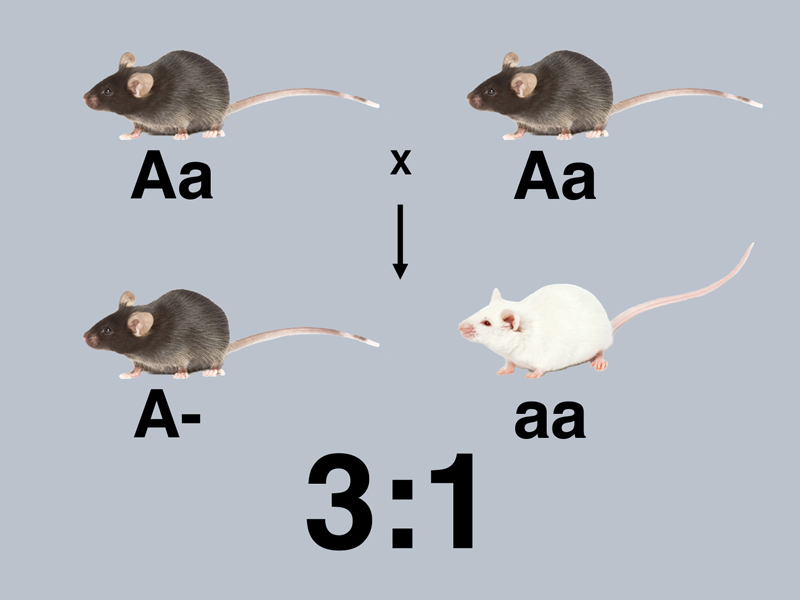
In these results, we have not yet resolved how many of the black mice are AA and how many are Aa. If we were to do this using testcrosses, we would see that the ratio of true-breeding black (AA) to black hybrids (Aa) to albinos (aa) is 1:2:1, as shown below.
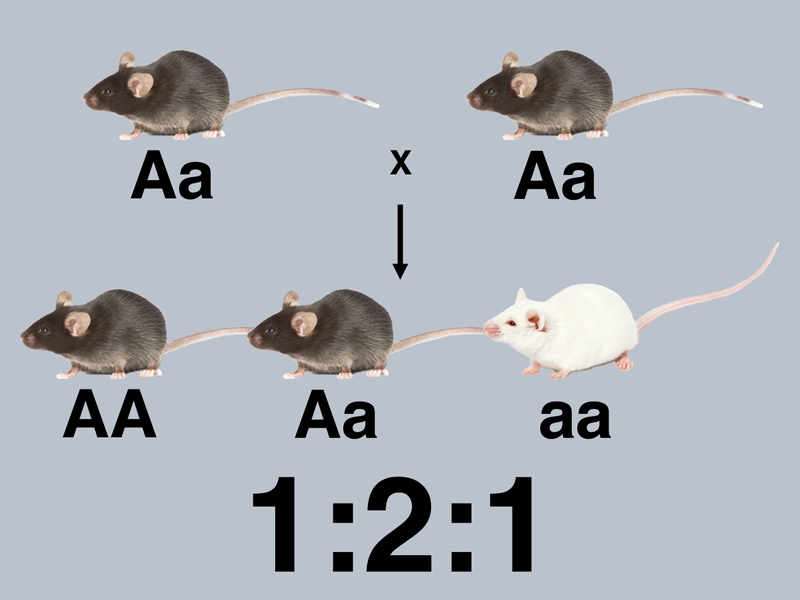
This is really the same problem as tossing two coins. The math shows us that a hybrid mouse has a coin-tossing mechanism that it uses to make gametes, which brought us to Mendel's First Law, the principle of segregation, which states that the two alleles present in a hybrid segregate from each other during the formation of gametes, just like homologous chromosomes.
We are now in a position to ask what happens when we conduct crosses with two pairs of alleles. Crosses in which alleles of two genes are segregating are called dihybrid crosses. We gave our mouse-crossing Mendel another variant to work with, a curious kind of mouse called a waltzer. Laboratory mice are derived from mice developed by Victorian mouse fanciers. There were fewer opportunities for entertainment in the Victorian era than there are today, and eccentric Victorians took to breeding unusual mice at home for amusement. They discovered an odd type of mouse called a waltzer, shown in the video below.
Waltzing mice tend to hold their heads in the air and spin around a lot. With a good dose of imagination, you might think that they were dancing a fast waltz. Whatever the music, it is inside their heads, because waltzing mice are deaf. We will indicate this trait in drawings with a musical note over the head of the mouse.
Waltzing is a recessive trait that behaves exactly like albino in monohybrid crosses.
We cross a true-breeding black non-waltzer (AABB) to a true-breeding albino waltzer (aabb), which produces dihybrid black non-waltzer (AaBb) in the F1, as shown below.
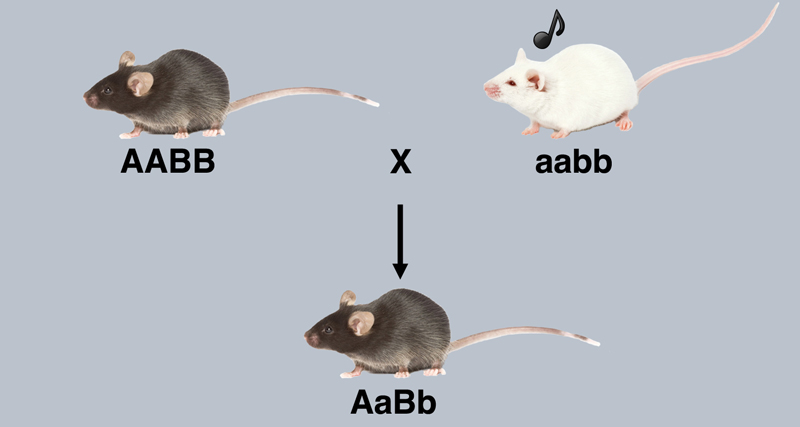
It is most informative to see what happens when we conduct a testcross with the F1 dihybrids, as shown below.
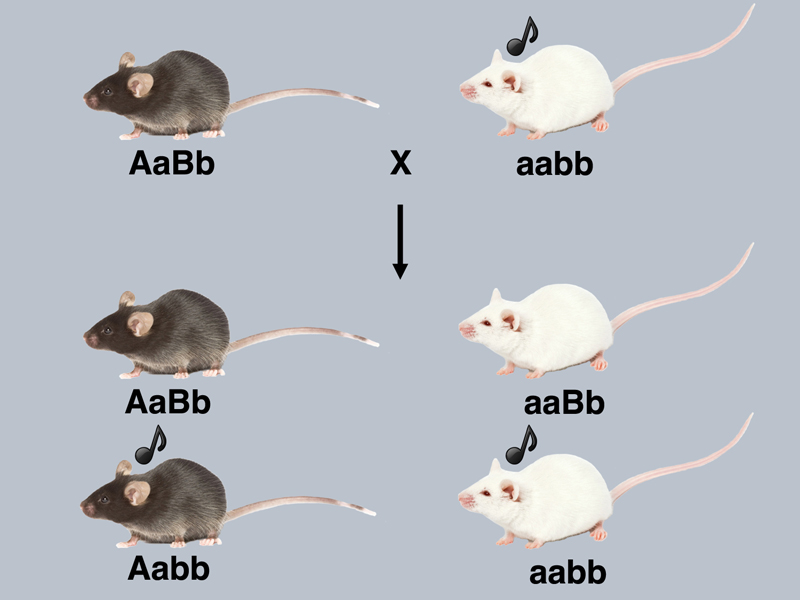
As we might expect, we see four types. No other types are possible. The great thing about the testcross is that there is no ambiguity about genotypes. Because every mouse gets an ab gamete from the albino waltzer (aabb), the phenotype tells us which of the four types of gametes that each mouse got from the F1 dihybrid (AaBb).
In crosses of this type, Mendel always found that the four gamete types (AB, ab, Ab, and aB) occurred in equal frequencies. Mathematically, this means that the sorting of A vs. a into gametes is independent of the sorting of B vs. b into gametes. The coin-flipping mechanism inside the mouse works independently for each pair of alleles.
The Punnett Square for the dihybrid testcross is shown below.
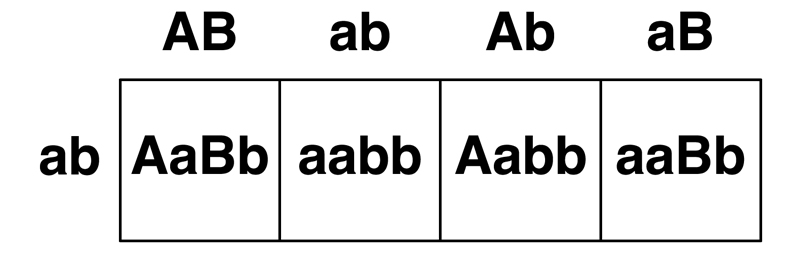
These results led Mendel to formulate the Second Law, the principle of independent assortment, which states that the two alleles of a pair of genes in a dihybrid will segregate independently during the formation of gametes. We are now ready to consider whether the behavior of chromosomes during meiosis gives us any insight into the Second Law.
Consider meiosis in an organism that has two pairs of homologous chromosomes. During metaphase of meiosis I, there will be two bivalents orienting themselves at the metaphase plate. Each bivalent consists of two homologous chromosomes that have replicated to produce four strands.
A particular bivalent might send its pair of maternally-derived sister centromeres to the pole on the left in the drawing or to the pole on the right at anaphase I. We can ask whether different bivalents orienting at the same time influence each other's orientation. There are cases in which there are structural differences between the homologs, like the XY pair in mammals. If we had another pair of chromosomes with a visible structural difference (these do exist in some organisms), we could observe this directly. The answer is that each bivalent orients independently of the others at metaphase I. There aren't any connections between one bivalent and another.
In the drawing below, one pair of chromosomes carries the A gene, which is heterozygous (Aa). The other pair carries the B gene, which is also heterozygous (Bb). In drawings on the left, the two maternally-derived chromosomes are oriented toward the same pole at metaphase I. The reductional division occurs normally to produce the two cells shown in the second drawing, which then divide equationally to produce ab and AB gametes. In the drawings on the right, the two maternally-derived chromosomes are oriented toward opposite poles at metaphase I. The reductional division occurs normally to produce the two cells shown in the second drawing, which then divide equationally to produce aB and Ab gametes.
We have shown meiosis as occurring without crossovers to simplify the drawing. We know from earlier lectures that this would create a situation in which bivalents lack chiasmata, which would interfere with metaphase I orientation. Satisfy yourself using a more complex drawing that crossovers do not alter the results.
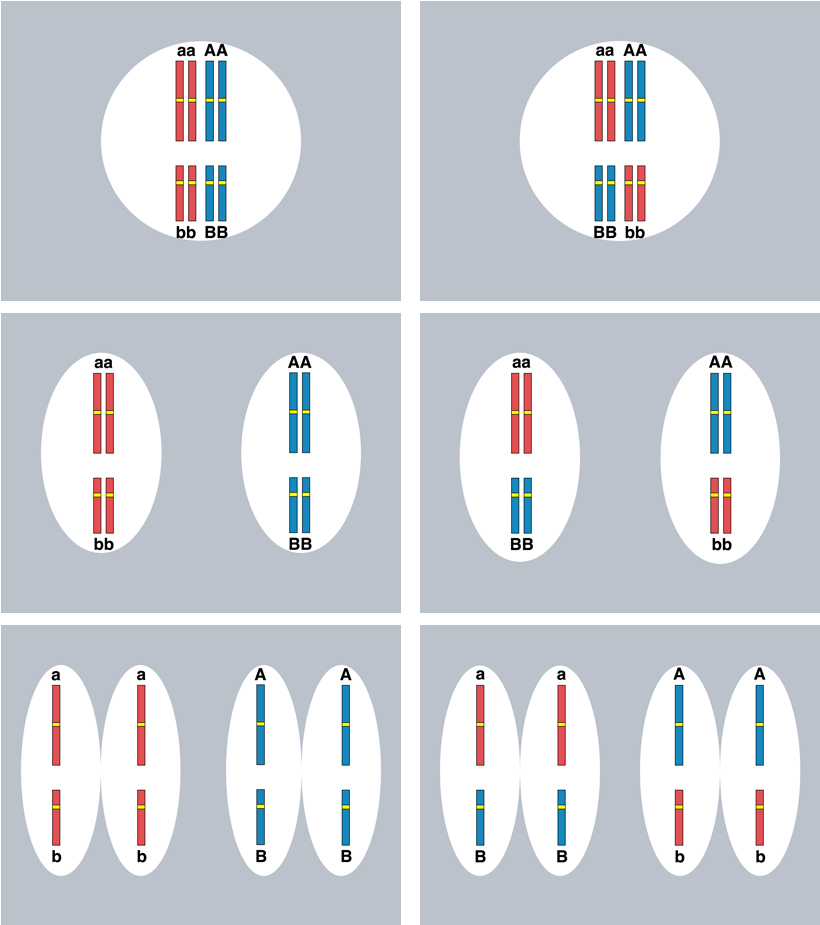
These drawings clearly show that chromosomes follow the First Law: homologous chromosomes segregate from each other during the formation of gametes, and each gamete contains only one member of each homologous pair. Chromosomes also follow the Second Law: the segregation of each chromosome pair occurs independently, shown in this drawing by the two different orientations.
At the end of this discussion, I pointed out that chromosomes don't follow Mendel's laws, they make them.
A student asked what would happen if two genes were on the same chromosome, a case that we will discuss in detail a few lectures from now. The answer is that we would observe a departure from independent assortment. Independent assortment as predicted by the Second Law is by far the most common case for pairs of genes picked at random, but the Second Law can be bent or broken, which is the basis for some of the most powerful techniques of genetic analysis in use today.
We left off our discussion of the dihybrid cross after showing that the dihybrid testcross (AaBb x aabb) was sufficient to demonstrate independent assortment. This is not the cross that Mendel did, however, and in most texts they follow the historical demonstration rather than the much clearer demonstration provided by a dihybrid testcross.
In an intercross, we cross pairs from the F1. The dihybrid intercross is therefore AaBb x AaBb, as shown below.
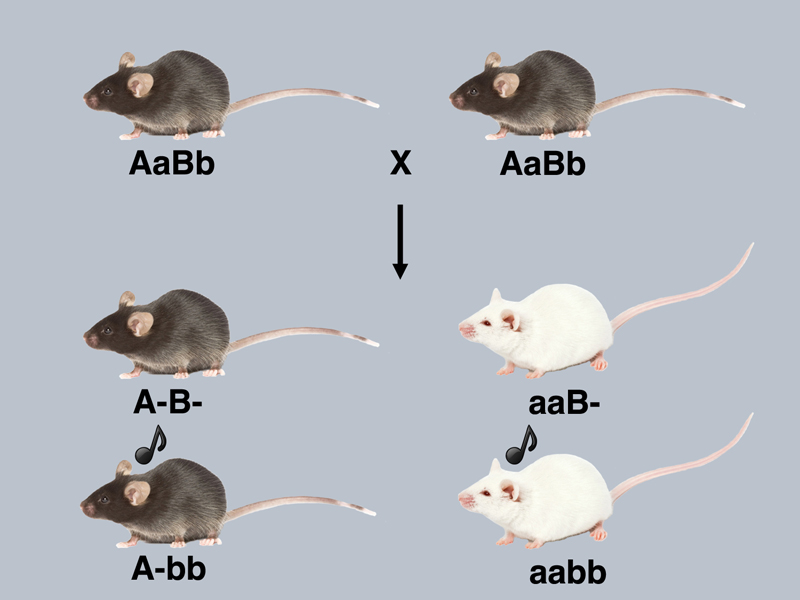
In this case, we are not able to determine the genotype of the offspring from their phenotype. The phenotypic ratio observed is a 9:3:3:1 ratio of A-B-:A-bb:aaB-:aabb. This is two 3:1 ratios superimposed onto each other. We can see the genotypes that produce these phenotypes in the Punnett Square below.
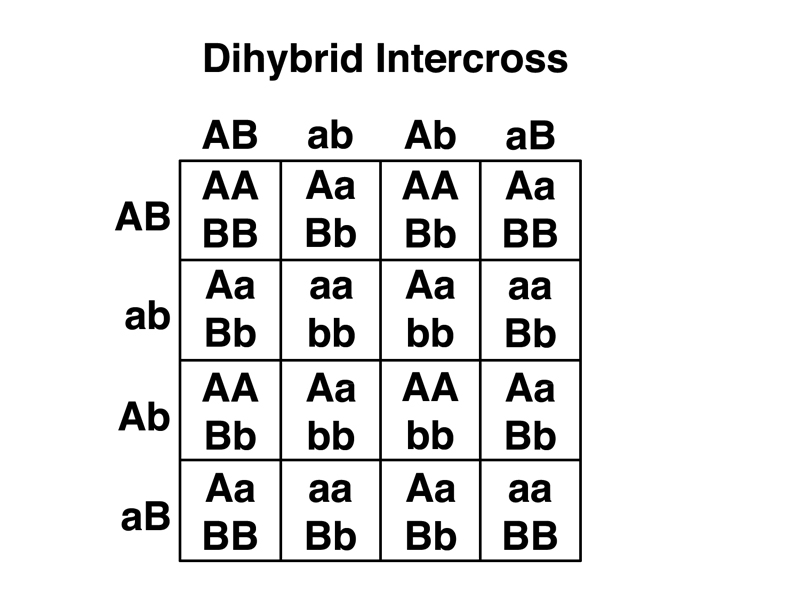
We worked some practice problems in class, adapted from the remarkable video lectures by Mr. Anderson on the Extras page. These problems are adapted from his Mendelism video.
Q1. A tossed coin has come up tails four times. What is the probability that the next time it is tossed, it will come up heads?
A. 1/2. No one had any trouble with this one.
Q2. Homozygous or Heterozygous?
Aa - heterozygous
Bb - heterozygous
aa - homozygous
AaBB - heterozygous for A, homozygous for B
No trouble here for most people. It's important to give a complete answer for the fourth case.
Q3. Genotype and Phenotype. Here albino (a) is recessive to black (A), and waltzer (b)
is recessive to non-waltzer (B). Students were asked to give the phenotype for each genotype.
Aa - black
Bb - non-waltzer
aa - albino
AaBb - black non-waltzer
So far, everyone is doing well.
Q4. What is the probability of producing an albino from each of the crosses shown?
Aa x aa
Aa x Aa
AA x aa
I worked these using Punnett Squares. You can get pretty fast doing it this way, and it is easy to avoid mistakes.
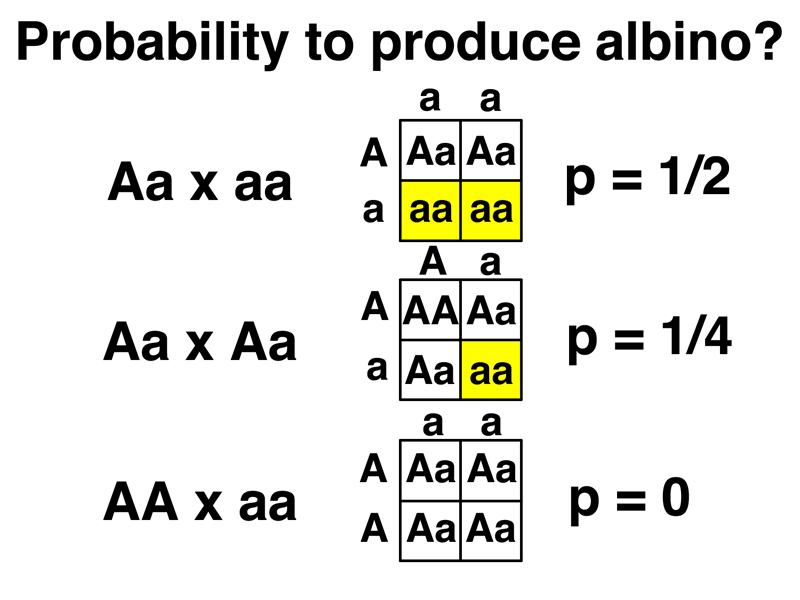
Q5. What is the probability that AaBb x AABb will produce AaBb?
You might be tempted to draw a big Punnett Square for this kind of problem, but it is easy to make mistakes that way and it's too slow. It is better to realize that because of the Second Law, we can solve the problem for A and B separately and then multiply to get the probability of the desired outcome, as shown below. This approach is also much better for a trihybrid cross. Thank you, Mr. Anderson!
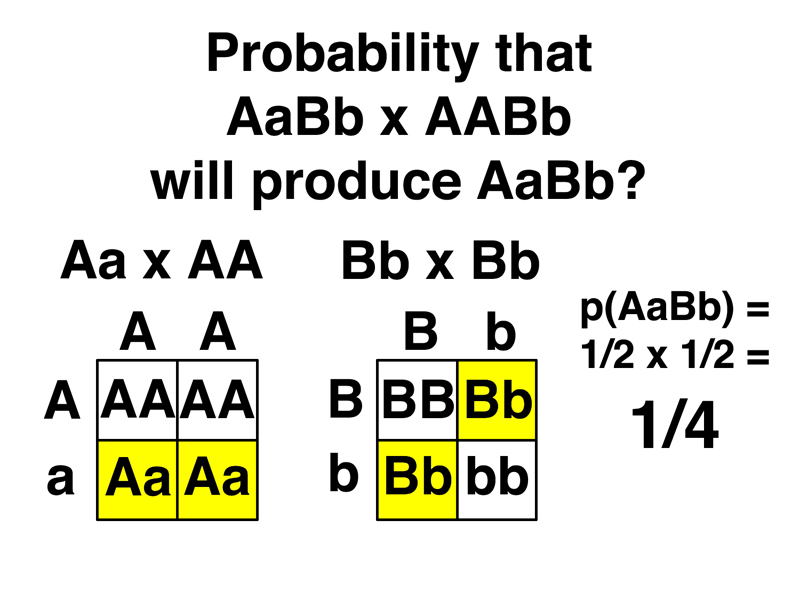
We went through monohybrid and dihybrid crosses without spending much time on the nature of alleles. In our examples, we used two alleles of the tyrosinase gene, one of which (A) encodes an enzyme with normal function, while the other (a) has a change of some kind that eliminates tyrosinase activity. We never discussed the biological basis of waltzer, although we had two alleles, the normal allele B and the recessive waltzer allele b.
In the glossary, we define "allele" as one of the variant forms of a gene, differing from other forms in its nucleotide sequence. This is a definition that is a little ahead of what we have covered about genes, although everyone knows that genes are made of DNA that somehow encodes proteins. It is easy to imagine that changes in the DNA sequence that encodes a protein like tyrosinase might cause it to make an enzyme that doesn't work.
But what is waltzer? We designated the two alleles that we used as B and b. We saw that bb homozygotes are deaf besides exhibiting waltzing behavior. One student suggested that the deafness points to some abnormality in the development of the inner ear, where there is also the vestibular system, a sensory system that allows us to keep our balance. This was very insightful, because that is exactly what is wrong with waltzers.
The variant that causes waltzer is a change in the sequence of the mouse Cdh23 gene, which encodes a cadherin. Cadherins are a family of membrane-spanning proteins with an extracellular domain consisting of repeats of a particular amino acid sequence. Some have multiple membrane-spanning domains, some have large intracellular domains, others have small intracellular domains that interact with other proteins. The extracellular repeats can associate with extracellular cadherin repeats on other cells, or with similar kinds of proteins that are not cadherins on other cells.
The correct nomenclature for the allele that we have been using is Cdh23v, which is the allele formerly known as waltzer (v). There is another variant allele, Cdhahl, which causes deafness in homozygotes, but not waltzing ("ahl" is short for "adult hearing loss"). This shows that there can be more than two alleles of a gene, although a particular individual only carries two alleles. Furthermore, it shows that different alleles can produce different phenotypes.
One student speculated on whether waltzing would be recessive to non-waltzing in the compound heterozygote Cdh23v/Cdh23ahl. While it is never possible to know this for sure without doing the cross, this example suggests that there is a hierarchy of defects from normal to deaf to both deaf and waltzing. It also points out that we should not use the terms dominant and recessive generically, but rather use these terms only to compare two alleles with respect to a particular trait or traits.
The multiple traits seen in waltzing mice include waltzing, head tilting, deafness, and a defective righting reflex (when waltzers are turned on their backs they don't immediately right themselves). We can understand these traits when we learn that waltzers exhibit defects in cochlear hair morphology. All of these traits are a consequence of defects of the development of the inner ear.
In humans, variant alleles of Cdh23 are one of the causes of Usher Syndrome. Patients with Usher Syndrome exhibit deafness, vestibular dysfunction, and retinitis pigmentosa. Variants of many other genes cause Usher Syndrome. We looked at an electron micrograph of a hair cell (in the inner hear, not a hair follicle of the skin) with an accompanying drawing that showed a few of the many proteins required to make this structure. Variant forms of many of the proteins identified in the drawing cause Usher Syndrome in homozygotes. This shows us that variation for some particular traits can result from variant alleles of many different genes. In the case of Usher Syndrome, it is usually not possible to identify the gene responsible simply by examining the patient; the symptoms produced by variant alleles of different genes are very similar.
You can read more about Usher Syndrome at OMIM.
We closed with a very brief overview of the human and mouse genomes, which encode about 22,000 proteins. If you use human genes to search the mouse genome, you find an equivalent gene for almost every human gene. The same is true if you search the human genome using mouse genes. There are perhaps 100-200 genes unique to either species. The toolkit of proteins to build a human being or a mouse is essentially the same. The biological differences betweens humans and mice must be explained by something other than the collection of proteins found in these two species. One student suggested that the differences must arise from differences in gene regulation during development, a subject that we will take up much later in the course.